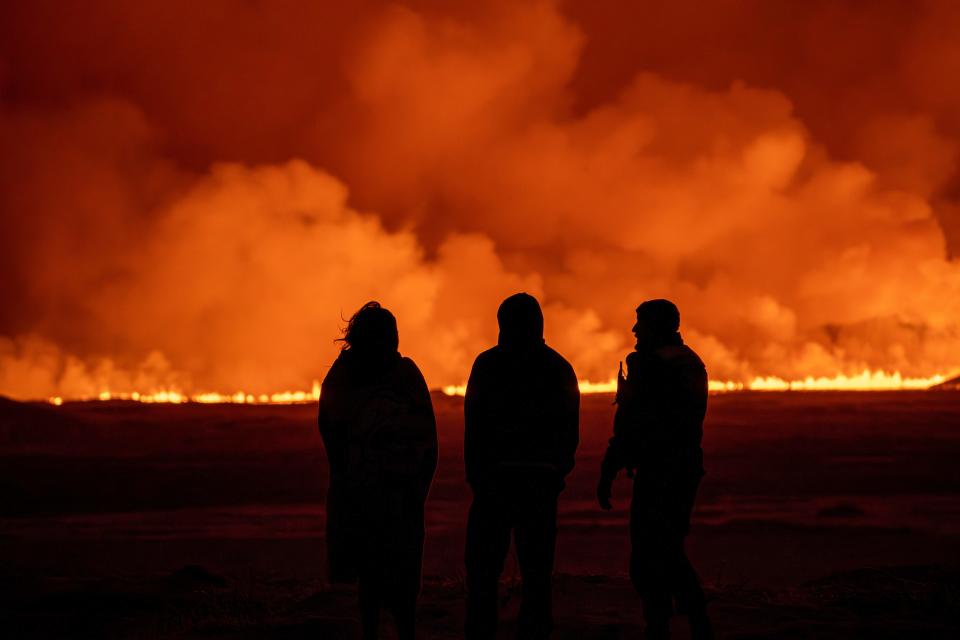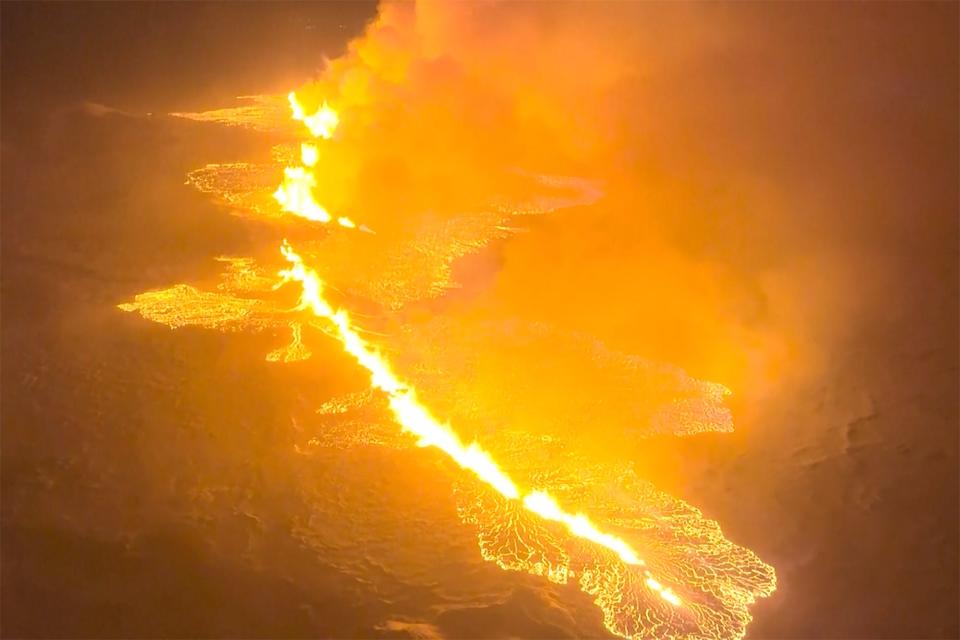Volcano eruption on Iceland's Reykjanes Peninsula continues after a month of anticipation
In preparation of the long-awaited eruption of a volcano in southwestern Iceland this week, thousands of residents were evacuated from a small fishing town on the Reykjanes Peninsula.
More than 4,000 people left the nearby fishing town of Grindavik, which is less than 2 miles from the site of the eruption, on Nov. 10 after seismic activity was detected in the area.
When did the volcano erupt?
The volcano erupted at 10:17 p.m. local time on Monday, spewing lava and creating a stunning visual spectacle. The eruption came after an initial earthquake at around 9 p.m.
As of Tuesday morning, the length of the ground fissure had expanded to 2.5 miles. The eruption occurred around 50 kilometers, or 31 miles from the country's capital of Reykjavik.
Local police announced that all routes to Grindavik were closed, except to first responders and other contractors working in the emergency zone. "We would like to ask people not to go to the eruption and remember that gases from this can be dangerous," police wrote in a Facebook post in Icelandic.
The intensity of the eruption is decreasing as the eruption reaches "equilibrium," the Icelandic Met Office reported on Tuesday.
"The fact that the activity is decreasing already is not an indication of how long the eruption will last, but rather that the eruption is reaching a state of equilibrium," the office wrote on its website.

See the photos: Iceland volcanic eruption following earthquakes
Nearby spa attraction closes
The Blue Lagoon Spa, a geothermal spa and the town's main attraction, temporarily closed its facilities Monday evening. The spa will stay closed at least until Dec. 27, according to a post on its website.
Operators of the Svartsengi power plant, a geothermal power plant around 2.5 miles from Grindavik, kept the plant open as the volcano raged and a state of emergency was declared. The power plant is unmanned and can be controlled remotely, HS Orka, the company that owns the plant, posted on Facebook.
Geologist Björn Oddson told the country's national public broadcasting service, RUV, that the lava was fortunately not flowing towards Grindavik. "It's in the best place if there was to be an eruption there," he said.
Katrin Jakobsdottir, prime minister of Iceland, told RUV, the country's national public broadcasting service, that although the lava did not pose a threat to critical infrastructure nearby, special precautions would be taken around the power plant.

Will the eruption disrupt flights?
Keflavik Airport, around 13 miles from Grindavik, was still functioning normally on Tuesday morning, although 13 flights had been canceled since the day before, according to flight-tracking service Flightradar24.
The airport set its aviation alert level to orange in November after activity around the volcano was detected, indicating than an eruption was underway.
What caused the volcano?
The volcano was caused by magma underneath the surface of the earth pushing two tectonic plates that meet in Iceland slightly apart – the same process that created the island itself.
"Over millions of years, that creates a whole bunch of new land, and that is how Iceland the island was formed," Jess Phoenix, a volcanologist and Science Ambassador for the Union of Concerned Scientists, told USA TODAY. "The planet is living and changing right beneath our feet."
The effect was a "fissure eruption," a lower degree of volcanic eruption that produces more "oozy" lava, Phoenix said.
Lava fountains that shoot up 20 to 50 feet "are the most dramatic thing that we will see aside from lava just oozing over rocks," she said. "So don't expect to see huge big explosions."
Phoenix deemed Monday's eruption a "best case scenario," as compared with past volcanic events.
"This one, fortunately, has really decreased in the volume of lava that it's putting out," she said. "We were getting 200 cubic meters per second last night and now we're seeing about 20 cubic meters a second."
Jess' biggest advice to anyone near a volcano: Don't get near it.
"Everything near an eruption is unstable. There is no safe area," she said.
The area around a volcano poses numerous hazards, including the temperature of the lava itself, which could be four times hotter than a kitchen oven.
An erupting volcano also emits acid gasses such as hydrogen fluoride and sulfur dioxide. "Those are not something you want to breathe," she said.
What past volcano eruptions happened in Iceland?
The eruption is the fourth to occur on the Reykjanes Peninsula in the past three years, according to a statement from the Icelandic government. A volcano erupts in Iceland every five years on average, but since 2021, that has increased to around once every 12 months, the government said.
"Iceland’s authorities are well prepared for seismic events which occur regularly as a feature of our country’s natural geography," the government statement read.
In 2010, a volcano on Iceland's southern coast erupted twice, first on March 20 and then two days later, it erupted again, this time for 71 days, according to the Icelandic government.
The twin eruptions triggered a state of emergency and the closure of European airspace beginning April 15 in response to the large clouds of ash that swept over parts of western Europe, according to NASA.
In August 2014, the Bardarbunga volcano erupted after two earthquakes of more than 5 in magnitude in the area. The eruption lasted into the following year.
Contributing: Associated Press
This article originally appeared on USA TODAY: Iceland volcano eruption on Reykjanes Peninsula causes evacuation

